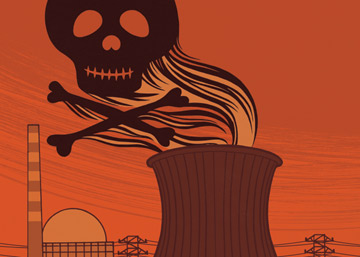
The originally published version of this story incorrectly stated that the Nuclear Energy Agency studies the nuclear industry in OPEC countries. In fact, it studies the nuclear industry in OECD countries.
In winter, when the temperature regularly falls to -4ºF (-20ºC), the Finnish island of Olkiluoto feels like the edge of the world. Today, the snow is falling so hard that visibility is down to a few meters, and the air is so cold that it's impossible to write with a pen because the ink freezes. But despite these harsh conditions, there is a blizzard of activity on this desolate isle, where the French firm Areva and the German giant Siemens have teamed up to build the first new nuclear power plant in Western Europe since 1986. Some 1,200 workers — as heavily bundled up as Arctic explorers — are putting the finishing touches to a 203-ft.-high (62 m) concrete cylinder designed to protect the reactor core from the force of a collision with a commercial aircraft. The giant cylinder has another purpose that is equally unsettling to contemplate: in case of a meltdown, it's intended to shield the outside world from the nuclear danger within.
Atomic energy is the most powerful and potentially destructive force man has discovered, so it's not surprising that a new reactor would be tucked away in a place as remote as Olkiluoto. Over the past 20 years, apocalyptic images of meltdowns and mushroom clouds led much of the world to call for the phasing out of nuclear plants. After growing 750% in the '70s, and 140% in the '80s, nuclear-generating capacity increased by only 8% in the '90s. But new fears — of sky-rocketing oil prices, global warming, and an overdependence on unpredictable but energy-rich countries like Russia and Iran — have sparked a reappraisal. Nuclear energy is back from the dead, and Olkiluoto is at the vanguard of its revival. Yet as the nuclear industry envisages a future in which dozens of new plants hum quietly around the world, others question whether this makes sense environmentally or commercially. In the emotional debate over the future of atomic energy, only one thing is clear: fission remains, like the technology underpinning it, fundamentally divisive.
The Price is Right
A decade ago, Finland — with its cold climate, long distances between cities, and energy-intensive industry — began looking for a way to meet its energy needs while living up to its Kyoto commitments to reduce greenhouse gases. Coal was cheap but crammed with polluting carbon. Thermal plants fueled by Russian gas seemed chancy given Finland's uneasy relationship with its neighbor. Renewable-energy sources like hydropower and wind, though promising, could not meet demand on their own. The debate kept circling back to the only other carbon-free option — nuclear. As Mikko Elo, a former MP who helped secure Finland's 2002 decision to build the new Olkiluoto reactor, recently put it: "If you worry about climate change there is no other economically or environmentally stable alternative to nuclear power."
That sentiment has quickly gained traction elsewhere in Europe, even in regions that have been staunchly antinuclear since a partial meltdown at the Chernobyl nuclear power station in Ukraine spewed a radioactive plume over the Continent 22 years ago. On Jan. 10, the British government reversed years of policy by proposing to streamline planning applications for reactors in the hope of opening new stations as early as 2017. British Secretary of State for Business John Hutton declared that nuclear power is "safe and secure" and that it's central to the country's goals for cutting greenhouse emissions. In Sweden, which decided even before Chernobyl to phase out nuclear power, an opinion poll released on Jan. 21 showed that almost half of voters now favor the technology. And even in Germany, where atomic fears helped spawn the nation's formidable green movement, many high-profile politicians, led by Chancellor Angela Merkel, are calling for the country's official opposition to nuclear energy to be overturned.
Outside Europe, the news is even brighter for the nuclear industry: globally, 34 nuclear plants are now being built in places as far afield as India, China, Russia and Argentina.
"Ten years ago, morale in [the nuclear industry] was rather low. People felt they were trapped by ecologists and gave the impression of a dead-end future," says Anne Lauvergeon, CEO of Areva, which is building the Olkiluoto reactor. "But we have nothing to hide. As a carbon-free and competitively priced energy source, nuclear has a significant role to play in the future."
Still, Lauvergeon's insistence that "nuclear is not the devil anymore" and that "the devil is coal" does not sit happily with environmental groups such as Friends of the Earth and Greenpeace. They say that because new reactors take at least 10-15 years to come online, nuclear energy is a futile distraction in the race to slow global warming. They also argue that the industry has yet to confront its toxic legacy — the fact that the splitting of uranium atoms creates isotopes that remain radioactive for thousands of years. Deep burial in certain geological structures would safely house nuclear waste, but it's notoriously difficult to persuade communities above them to accept such repositories. So far, there is only one in the world — in Olkiluoto.